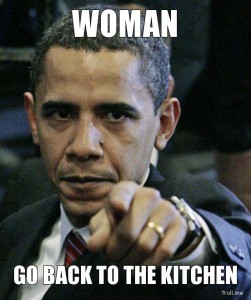Friday, August 8, 2014 10:12 pm
The Muted-Group Theory claims that because languages of cultures are MAN-made, the language aids in defining, depreciating, and excluding women and that when women attempt to overcome inequality, the fact that communication is dominated by men, they remain at a disadvantage. In other words, because men act as the gatekeeper of communication within a society, the language, itself, as a tool to perpetuate the oppression of the marginalized.
This viral campaign, produced by ALWAYS (a company that manufactures and sells feminine hygiene products), acts as a form of female empowerment by attempting to shed some light on the use of certain language that demeans the female gender. It portrays the idea that language acts as a tool to oppress those groups not in power.
https://www.youtube.com/watch?v=XjJQBjWYDTs
Friday, August 8, 2014 10:09 pm
The Standpoint Theory is very similar to Deborah Tannen’s Genderlect Theory, however, the developers of the Standpoint Theory cast a broader net. They argue that your view of the world is dependent on where you sit in life. The theory states at the different locations within a social hierarchy allow for different experiences, interpretations, and perceptions of the world. Through the critical tradition of this theory, they argue that the standpoints of the marginalized people provide less false views of the world than do the privileged perspectives of the powerful. In other words, those in power are more blind to what occurs in the real world, they’re blinded because they don’t know what’s really going on.
An example of this theory could be seen in the famous historical quote falsely attributed to Marie Antoinette; “Let them eat cake.” As tradition goes, Marie Antoinette was so blinded by the power of her nobility that she assumed that if the peasants didn’t have bread to eat, then they should just eat cake. Her role at the peak of French Society provides a more false view of the world; she’s only able to see how nobility experience and perceive life and thusly applies these views/beliefs on the entire population of her society.

Friday, August 8, 2014 10:06 pm
The Genderlect Theory was developed by Deborah Tannen to explain the difference between the communicative styles of men and women. Tannen believes that the main cause of miscommunication between men and women is the fact that neither party realizes that their encounters are cross-cultural. This premise is rooted in the idea that the ways in which Men and Women experience the world, are completely different. Because of these fundamental differences in the way in which men and women perceive the world their resulting interactions differ and lend themselves to the formation of two different “gender cultures”.
Tannen goes on to describe certain ways in which the differing cultures make the way in which they interact, different. The main difference between the two groups is their communicative goals; mean seek to affirm their status within their society and women seek to form a human connection during interaction. Women attempt to form connections in many different ways such as offering nonverbal cues such as head nods, offering supportive feedback during conversations, or interrupting to share agreement.
Friday, August 8, 2014 10:05 pm
Philipsen’s Speech Code Theory says that each and every culture has their own speech codes. Speech Codes are systems of socially constructed symbols and meanings, premises, and rules that pertain to interaction between those who make up the particular culture. These speech codes used by speakers and listeners are utilized to create and interpret their communication which make up their realities.
If one were to view the culture and communication of the Lumbee Indians of south-eastern North Carolina they’d easily be able to see support for the Speech Codes Theory. This tribe has developed its own particular speech codes that flood their communication. Their speech codes are woven into their communication and become more prevalent when you view the interaction between those who share the culture.
Friday, August 8, 2014 5:33 pm
Muted group theory is a theory created by Cherish Kramarae stating that women are a muted group in society, and that men created and control the societal language. Sexual harassment is very common in the muted group theory as the power levels between men and women and different. This power level creates an imbalance with men trying to impose their power on women in the form of sexual expression. Typically people higher up in the workforce (usually men) harass lower level workers (usually women). There are very few cases of women sexually harassing men for this reason.
Thursday, August 7, 2014 4:46 pm
In the theory created by Cherish Kramarae women is a muted group, due to the thought that man created language. In the muted group women are involved in sexual harassment. This harassment takes place when sexual interactions are not wanted in a unequal relationship. The common harassing comes from the men pursuing the woman in a powerful way. Cherish Kramarae is defined as people belonging to a low-power group who must change their language when communicating publicly, even though their ideas are more likely to be overlooked.

Thursday, August 7, 2014 1:41 pm
The Muted Group theory was created by Cheris Kramarae and defined as people belonging to low-power groups who must change their language when communicating publicly, thus, their ideas are often overlooked”. In this theory, women are the muted group because language is a man-made structure. As being part of the muted group women engage in sexual harassment which means unwanted imposition of sexual requirements in the context of a relationship of unequal power. In most cases it men harassing women because of the power levels are different.

Wednesday, August 6, 2014 8:10 pm
Cheris Kramarae’s Muted Group Theory is defined as “people belonging to low-power groups who must change their language when communicating publicly, thus, their ideas are often overlooked.” According to Kramarae, women’s words are discounted in society, women are the muted group in society, and language is literally man-made. As a result, women experience the Muted Group Theory and then sexual harassment, which is an unwanted imposition of sexual requirements in the context of a relationship of unequal power. This is because people with the power are intimidating to the people with less power, in this case men vs women. For example, bosses in the workplace are usually sexually harassing their employees, solely because women are regularly ignored and the man is in power.

Wednesday, August 6, 2014 8:08 pm
Created by Cheris Kramarae, the muted group theory states that language is “literally a man-made construction.” According to Kramarae, a muted group is a group of people who belong to low-power groups who must change their language when communicating publicly, thus, their ideas are often overlooked. A recurring example of a muted group used by Kramarae is women. According to her and other feminist theorists, women’s words are discounted in our society and their thoughts are devalued. This is apparent everyday in the daily life of some. As I scroll through the feeds on social networks, there are examples of women’s opinions not even being took into consideration by some men in conversation.

Wednesday, August 6, 2014 7:35 pm
The standpoint theory, created by Sandra Harding and Julia T. Wood, basically states “where you sit is where you stand.” Standpoint is defined as a place from which to critically view the world around us. Depending on where you are socially, geographically, etc., your view on the world may be different from someone who is at a different vantage point. An example of this is present in everyday life between parents and children, police and civilians, teachers and students, etc.









